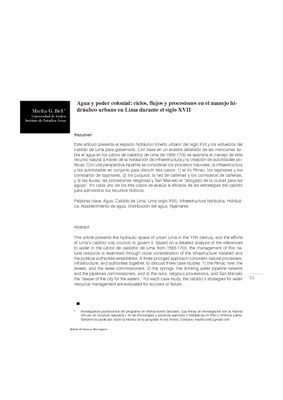| dc.contributor.author | Bell, Martha Gwenn | es_ES |
| dc.date.accessioned | 2018-04-10T16:51:07Z | |
| dc.date.available | 2018-04-10T16:51:07Z | |
| dc.date.issued | 2014 | es_ES |
| dc.identifier.uri | http://repositorio.pucp.edu.pe/index/handle/123456789/114078 | |
| dc.description.abstract | Este artículo presenta el espacio hidráulico limeño urbano del siglo XVII y los esfuerzos delcabildo de Lima para gobernarlo. Con base en un análisis detallado de las menciones sobreel agua en los Libros de cabildos de Lima de 1588-1700 se examina el manejo de esterecurso natural a través de la instalación de infraestructura y la creación de autoridades políticas.Con una perspectiva tripartita se consideran los procesos naturales, la infraestructuray las autoridades en conjunto para discutir tres casos: 1) el río Rímac, los tajamares y loscomisarios de tajamares, 2) los puquios, la red de cañerías y los comisarios de cañerías,y 3) las lluvias, las procesiones religiosas y San Marcelo el “abogado de la ciudad para lasaguas”. En cada uno de los tres casos se evalúa la efi cacia de las estrategias del cabildopara administrar los recursos hídricos. | es_ES |
| dc.description.abstract | This article presents the hydraulic space of urban Lima in the 17th century, and the effortsof Lima’s cabildo (city council) to govern it. Based on a detailed analysis of the referencesto water in the Libros de cabildos de Lima from 1588-1700, the management of this naturalresource is examined through close consideration of the infrastructure installed andthe political authorities established. A three-pronged approach considers natural processes,infrastructure, and authorities together, to discuss three case studies: 1) the Rímac river, thelevees, and the levee commissioners, 2) the springs, the drinking water pipeline networkand the pipelines commissioners, and 3) the rains, religious processions, and San Marcelothe “lawyer of the city for the waters.” For each case study, the cabildo’s strategies for waterresource management are evaluated for success or failure. | en_US |
| dc.format | application/pdf | es_ES |
| dc.language.iso | spa | |
| dc.publisher | Pontificia Universidad Católica del Perú. Instituto Riva Agüero | es_ES |
| dc.rights | Attribution 4.0 International | * |
| dc.rights | info:eu-repo/semantics/openAccess | es_ES |
| dc.rights.uri | http://creativecommons.org/licenses/by/4.0 | es_ES |
| dc.source | Boletín del Instituto Riva-Agüero; No. 37 (2014) | es_ES |
| dc.subject | Revistas generales | es_ES |
| dc.subject | Historiografía—Revistas | es_ES |
| dc.subject | Filosofía--Revistas | es_ES |
| dc.subject | Water | en_US |
| dc.subject | Cabildo Of Lima | en_US |
| dc.subject | Lima (17th Century) | en_US |
| dc.subject | Hydraulic Infrastructure | en_US |
| dc.subject | Hydraulics | en_US |
| dc.subject | Water Supply | en_US |
| dc.subject | Water Distribution | en_US |
| dc.subject | Levees | en_US |
| dc.title | Agua y poder colonial: ciclos, flujos y procesiones en el manejo hidráulico urbano en Lima durante el siglo XVII | es_ES |
| dc.type | info:eu-repo/semantics/article | |
| dc.type.other | Artículo | |
| dc.subject.ocde | https://purl.org/pe-repo/ocde/ford#6.00.00 | |
| dc.publisher.country | PE | |


